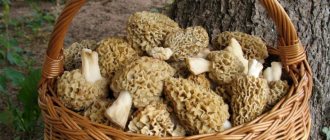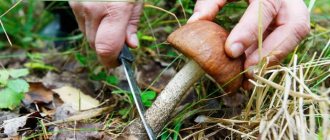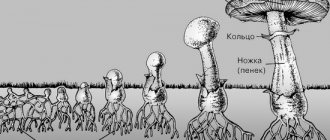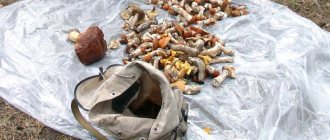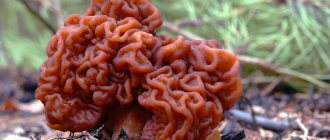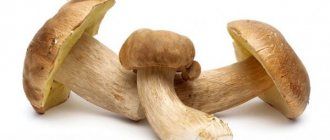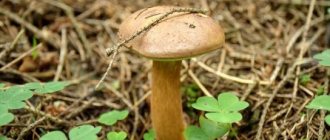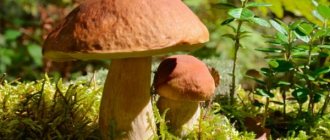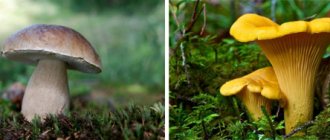Midsummer is the time of fragrance and flowering of all nature. Although the month of July is not the peak of the mushroom season, it is in this month that you can make your first test forays into the forest.
July, as the mushroom calendar records, is not one of the most successful months for mushroom pickers. There is little rain during this period, and the scorching sun simply does not allow mushrooms to grow and develop normally. This means that during this period you should not hope for a special harvest of mushrooms. But, nevertheless, if the weather is rainy, then you can safely go into the forest in search of boletus, aspen boletuses, boletus and chanterelles.
The earliest edible mushrooms in spring: names, list
In the northern zone of Russia, spring is a “dead season” for mushroom pickers. But for the southern direction, even in March you can collect winter honey fungus and oyster mushrooms.
Oyster mushroom
To find oyster mushrooms, pay attention to old, perennial aspen, poplar, and ash trees.
Winter mushrooms also grow not on the ground, but on old willows and willow bushes, but they are also found on maples and aspens.
Winter mushrooms
And if an alder or elderberry grows near you, which is many, many years old, look for the Black Wood Mushroom Muer, also called Judas’s Ear and having a scientific name - Auricularia auricularis. You will be sincerely surprised, but this delicious Muer is sold in our supermarkets at incredibly high prices. Indeed, for Asians this is a delicacy, but we have a lot of this mushroom and can be collected all year round, but the most delicious, of course, is collected in the spring.
Black tree mushroom Muer
In hilly areas, you can already look for March or early Hygrophorus in early spring. It grows in deciduous forests under the tubercles of fallen leaves in autumn. In order to find it, you need to stir up a lot of tubercles, but once you find one, you will immediately pick up more than one basket of mushrooms.
Hygrofor March
Chanterelles
One of the few mushrooms that has a very pleasant quality - the complete absence of worms. But in terms of its taste, it is not for everyone, although it is very useful for the body, especially as a good natural anthelmintic.
It grows mainly in birch forests (no matter what anyone says, I have never seen it in other places); according to some information, it can form mycorrhiza with other trees.
For villagers, this mushroom is a good hack. They like to collect it in whole bodies, and then sell it to city residents at a very inflated price. They don’t eat it themselves, they say it’s tasteless.
Chanterelles bear fruit approximately from the end of June to September , but their mass emergence occurs in the first half of July .
More detailed information about chanterelles and their varieties can be found in the article “Chanterelles: varieties, places and times of collection.”
What edible mushrooms can be collected in spring in May: list, names, photos
By April, morel caps are already found in almost all regions of Russia, most often called simply morels among mushroom pickers. A characteristic feature of this mushroom is that the free edge of the cap is not attached to the cap.
Morel caps in May
The place to look for morel caps is under aspen trees, in lowlands where there is constant moisture, and in grass dusted with last year's leaves. By the end of April, the morel caps are gone.
Another type of spring mushroom is the conical cap. The edges of the cap are loose, but without dents. There are no pores or plates under the cap (they are very small and invisible).
In order to understand that this is an edible mushroom, the easiest way is to walk with an experienced mushroom picker and listen to his story, look at him and his inedible brother in person. Therefore, beginners pass by, and experienced ones come out with baskets full of spring mushrooms.
Conical cap
When “hunting” for a brown cap, do not pass by the bright red sarcosciphs. On rotten wood and old branches, colorful bouquets are scattered among the foliage. The mushroom is unique, and many people ignore it due to the liquid consistency of the mushroom and significant boiling during cooking.
Bright red sarcosciphae
But towards the end of April you can look for lines. If you are in a pine forest and there is sand under your feet, look to see if “brains” are scattered anywhere. This is exactly what this popular spring mushroom looks like.
Stitches in spring
Morels have recently lost their popularity, as they overly actively absorb all harmful substances from the environment (this is exactly why nature created them).
Therefore, their collection has been stopped in almost all regions - even after prolonged heat treatment they can be life-threatening! Collections remained exclusively in the northern territories, where in ecologically clean zones this type of mushroom is still acceptable for food.
But the giant, conical morel, also called brown, is absolutely safe, besides beautiful and tasty. It can be found on light sandy soils from the beginning of April until the coldest weather. They grow in clumps, so if you find one, look around.
Brown morel
Closer to the May holidays, in the damp plains, near rivers and lakes, look for the May Row. When washed, soapy water is formed, this is a normal feature of this mushroom.
Because of the specific taste, some mushroom pickers discard even the thought of collecting it, but experienced comrades not only collect it, but even export it to European countries, because there they buy it for amazing money in restaurants. May row in the hands of an experienced chef is a world-famous delicacy.
May row
Want to try mushroom chicken breast? Then in May, go for the sulfur-yellow tinder fungus. You can either love it or not perceive it at all.
There are no indifferent people. They grow on willows and acacias around ponds. Only bright young mushrooms that are pleasant and juicy to the touch are suitable for harvesting.
Sulfur-yellow tinder fungus
If you are relaxing near the swamps, do not forget to look for the tiger polypore; it grows on old tree branches and stumps in large families. You can collect up to two baskets from one branch!
Tiger polypore
And in the greenery nearby you can find the scaly tinder fungus. It also grows in clearings, but only where water from rivers and lakes spills in early spring.
Scaly polypore
Among deciduous, and especially oak groves, deer mushroom grows in May and early summer. The taste qualities of this mushroom are controversial and are not always accepted by mushroom pickers.
Deer mushroom
Did you go on vacation in the spring to the village or to the dachas? Go to the gardens, not only do the trees bloom beautifully there, but you can also collect garden Entoloma. This mushroom especially loves proximity to apricot, apple and cherry trees.
Entoloma garden
But the second half of May is especially loved by mushroom pickers - after all, it is then that the first and most spring boletus can be found on the edges and in young pines!
Spring boletus
In mixed forests you can easily find the first boletus mushrooms, and on the edges and lowlands the first porcini mushrooms are hatching!
The first boletus
The first porcini mushrooms
And for those who know flooded rivers and lakes surrounded by clearings, it’s worth trying your luck and collecting the first champignons as soon as the funeral days are over, as soon as the sun begins to warm up so much that you can walk without outerwear.
The first champignons
For rural areas, don't forget to look for white dung beetle, a delicious delicacy, at the end of May. But here are its brothers: homemade and shimmering ones should not even be touched, because the taste is peculiar, and not everyone likes it, and with alcohol they are completely poisonous.
You should also be careful with white fruit; only snow-white fruits are suitable for food, but the darkening cap indicates that it is unsuitable for people.
White dung beetle
In the forests you can find mushrooms that taste original: psatirellas, melanoleucas, saucers, and tremors. Also in the spring in the forests you can find many other mushrooms, both edible and questionable, as well as poisonous. But we did not include mushrooms that have no nutritional value in this list.
Psatirella velvety
Melanoleuca striapodosa
Saucers
Trembling
Stitches
Now the most controversial of spring mushrooms will go. Their inconsistency lies in the fact that in Russia, from time immemorial, lines have been devoured by both cheeks, and in the West they are poisoned with them, including with a fatal outcome [1]. kaput"..
The whole point here is the inconsistent concentration of a special toxin contained in the lines. Usually it is such that one or two boils are enough to neutralize the poison. However, sometimes the content of this poison goes off scale, and no amount of boiling helps. Rumor has it that six months of drying can completely get rid of the toxin, but scientists warn that everything here depends on how much poison has accumulated in the fruiting body of the mushroom.
That is, if there is enough of it in the mushroom, no amount of drying or boiling will save you from terrible poisoning.
On top of that, different people’s bodies tolerate string toxin differently. Some people don’t even give a damn about it - there are cases when particularly crazy mushroom pickers ate armfuls of lines in their raw form, and - “at least henna.” But another, more unpleasant statistic is also known - when even a fully processed mushroom with a minute concentration of toxin caused serious poisoning in the eater.
To collect or not to collect lines? This is a voluntary activity of every mushroom picker, but at his own peril and risk .
Nevertheless, we will still consider these spring mushrooms.
By the way, there are actually many more varieties of strings than are described below, and in general a more detailed narrative is devoted to these mushrooms: “String mushrooms: photos, descriptions and something about toxicity.”
Ordinary stitch
It has been noticed that this mushroom prefers coniferous forests to deciduous forests. Loves old burnt areas and clearings, as well as sandy soils.
It bears fruit in late April - early May , and so on almost until June .
The line is gigantic
The largest of the lines. It differs from the previous one in the lighter color of the “hat”. Appears in birch forests and mixed (but always with birch) forests in late April-early May.
It bears fruit until the end of May , less often until the beginning of June .
It grows in well-warmed places - edges, clearings, etc. Like all lines, it feeds on decaying wood dust.
What edible mushrooms can be collected in the summer at the beginning and end of June: list, names, photos
In June, wheat and rye begin to emerge in the fields, which means that in all regions of our delightful country you can start looking for boletus, aspen mushrooms and, of course, porcini mushrooms.
It is worth collecting 3-4 days after the rain. But if you really want to, then you can go in two days for the first hunt, especially if there are a lot of competing mushroom pickers in your area.
boletus
Boletus
White mushroom in summer
In the pine forest, in damp places you can find boletus. They grow in large groups and grow so quickly that you only have to blink. If you find them once, remember the place and come again in a few days.
Butterfly in summer
By the middle of the month, you can already find summer honey mushrooms, and they bear fruit until November. Remember or mark on the map where you collected them and you can collect them again and again for the next six months.
Summer honey mushrooms
In addition, russula (they are delicious when pickled), as well as the popular chanterelles, begin to grow on country paths and in mixed forests.
Russula
In the fields, as well as birch and pine plantations, you will find luxurious thickets of puffball. It will rain in the morning, and by lunchtime there will be a field of mushrooms. Take it and collect it!
Thickets of puffball mushrooms
Also in mixed and coniferous forests you will find green moss, wood-loving collibia, and forest champignons.
Green moss
Wood-loving collibias
Forest champignons
Meadow honey fungus grows in meadows and near lakes. Their advantage is their small size and large piles that cover the clearings.
Meadow honey fungus
And when talking about June mushrooms, it is impossible not to mention the delicious pigs.
pigs
For those who go out on a quiet hunt in bushes and mixed forests at the end of June, it is worth looking carefully for valui. But remember - edible mushrooms are young, with a cap not reaching 10 cm. If a depression with liquid appears in the middle, you shouldn’t even pick them, they are already poisonous.
Valui
For those who like to poke around in the forest foliage in June, there is something to do - for example, look for Podgruzdki. They grow in a peculiar way, half in the ground, half under the foliage. You can never find them from the outside, only by looking at the tubercle of leaves. But if you already find one, you’ll probably collect a basket, or even a bag of goodies.
Loadings
Also, do not overlook the summer honey fungus. It is smaller than usual, but its taste is in no way inferior.
Summer honey fungus
Umbrellas
A very interesting group of mushrooms, among which there are both edible ones - with very high taste qualities, and frankly poisonous species. Unfortunately, due to the strong external similarity, only seasoned mushroom pickers can distinguish good umbrellas from bad ones. I strongly do not recommend that novice mushroom pickers get involved with umbrellas until they have the proper knowledge and experience.
The most recognizable of the edible umbrellas is the variegated umbrella (shown in the photo above). It grows in open areas - meadows, pastures, forest edges. It is distinguished by a darkish cap, covered with variegated scales, and also by the fact that its flesh does not change color when pressed or cut.
They begin to grow in mid-June , appearing in whole groups, and continue to appear until the first half of October .
What edible mushrooms can be collected at the beginning and end of July: list, names, photos
Those mushrooms that we wrote about in the June section continue to bear fruit throughout July, and delicious milk mushrooms are added to them.
Milk mushrooms
Also in the forests you can come across a mushroom with a pink cap with a diameter of up to 10-12 cm. This is a pink mushroom, which many people like to pickle in the winter.
Volnushka pink
In deciduous and occasionally coniferous forests you can find graylings already in mid-summer. But this is only the beginning, so they are still found only sporadically, but closer to autumn they can be found in entire clearings.
Serushki
Butter
Another numerous genus of mushrooms, combining about four dozen different species. A couple of them (dozens) definitely grow in our country.
Boletus, along with russula, are one of the earliest summer mushrooms; moreover, they are known for the fact that they begin to appear together. Their only drawback is increased worminess (up to eight mushrooms per dozen), but nothing can be done about that, because the taste of butter mushrooms has always been excellent.
They grow in different forests, but are more inclined towards conifers. There are especially many butterflies in young, well-warmed pine forests. It is better to collect these mushrooms with cloth gloves, otherwise your hands will be stained with mushroom “snot” and dirt adhering to them.
Butterflies begin to grow in mid-June and continue to appear almost until October . The peak of their fruiting occurs in August-September .
More details about boletus mushrooms are described in the article “Boletus mushrooms: 25 varieties (photos and description).”
What edible mushrooms can be collected at the beginning and end of August: list, names, photos
Although called autumn mushrooms, they begin to bear fruit already in August. You can look for them after rains in well-lit places.
Autumn honey mushrooms
In August, bright and tasty saffron milk appears. It is so juicy and looks beautiful on the table that it is very popular at banquets. And small saffron milk caps are ideal for decorating dishes.
Ryzhik
Another gift of nature in August is the Polish mushroom. It can be found under oaks, chestnuts, beeches and in coniferous forests where the sun shines through well.
Polish mushroom
August also brings other varieties of moss mushrooms. They should be collected 3-4 days after the rain, when they have grown well, but have not yet become old. Large, overripe flywheels are not suitable for food.
Mosswort
Tips for beginner mushroom pickers
It is best to collect mushrooms in the morning, using baskets made of willow twigs. Collected mushrooms are placed in baskets with their caps down, and specimens with very long legs can be placed sideways. It is not recommended to use backpacks, bags and buckets for collecting mushrooms, where the fruiting bodies begin to deteriorate as quickly as possible.
The mushroom picker must adhere to several rules:
- You can only collect well-known mushrooms;
- mushrooms with a tuberous thickening at the base of the fruiting body stalk are poisonous;
- It is impossible to collect and process overripe, wormy, flabby and rotten mushrooms for food purposes;
- It is prohibited to taste and cut unknown mushrooms;
- in order to protect yourself from the use of environmentally polluting mushrooms as food, you should not collect fruiting bodies along traffic intersections, railways, highways and industrial zones;
- any types of mushrooms, regardless of the method of preparation, should not be given to children under three years of age;
- Persons with a history of kidney disease, as well as those suffering from liver or gastrointestinal tract diseases should not overuse mushroom dishes.
The most popular
Everyone knows what a champignon is. These are the most popular mushrooms in the retail chain. In the wild, pecheritsa, or common champignon, grows on soils rich in humus, in parks, gardens, and near human habitation. These mushrooms often form “witch circles” of quite large sizes. These circles in frequently visited places are formed mainly by poisonous species, but in remote corners they can be created by champignons and talkers, milkweeds and morels.
Saffron milk caps
Saffron milk caps are rightfully considered the best autumn mushrooms. Firstly, for its popularity, and secondly, for its excellent taste (even in Latin, saffron milk cap is called “delicious milkweed”). These mushrooms are especially good when salted.
There are three varieties - the well-known real camelina (in the photo), red camelina and spruce camelina. They are all very similar to each other and differ slightly in appearance. They prefer to grow in coniferous (pine or spruce) forests, especially young forest plantations.
Saffron milk caps begin to appear around mid-August and continue until the very end of September . However, from time to time they can delight the mushroom picker with a short wave in early July .
It turns out that saffron milk cap is not the only mushroom; there are several varieties of it, including some that are quite unusual in appearance. You can read more about these mushrooms in the article “Where saffron milk caps grow: forests, places and times of collection.”
Bitters
I admit, I have seen a lot of these mushrooms in my time, but I have never collected them and, moreover, I have never cooked them. This is how it happened in the Urals - alas, bitter mushrooms are considered the most toadstools. In general, this mushroom is considered second-rate even among its admirers. That is, if they take it, it is only when there is nothing else to collect.
Our Western colleagues, mushroom pickers, agree with us in this regard, and consider bitter mushrooms a generally inedible species. However, according to experts, it is quite possible to eat them - salted or pickled. But first you should soak it.
Bitterweeds grow in coniferous and deciduous forests, and I’ll tell you this - there are a lot of them there (since no one collects them).
These mushrooms bear fruit from late June to October .
I almost forgot! One unpleasant feature has been discovered with bitters - they accumulate radionuclides very well . So, if you live in the Chernobyl protection zone, or somewhere near Chelyabinsk, it is better to refrain from collecting these mushrooms.
Benefit
Mushrooms, especially July mushrooms, have numerous beneficial qualities and are high in calories. Gourmets call them “forest meat.” Their pulp is rich in many micro- and macroelements (potassium, phosphorus, calcium, sodium) and vitamins: carotene, D, C and group B.
Porcini mushrooms contain more protein than beef. It's healthier to eat them than a grilled steak because they contain much less unhealthy fat.
Milk milk solves kidney problems and helps in solving problems associated with urolithiasis. The active substances of these forest inhabitants prevent the formation of urates and axalates. A specific substance contained in mushrooms, lactrioviolin, prevents Koch bacilli from multiplying and prevents the development of tuberculosis, and also helps in the treatment of diseases of bacterial origin.
Chanterelles are a natural antibiotic. The immune system, thanks to the large amount of vitamins A1, B1, zinc and selenium in their composition, begins to work more stably. They are especially useful for diabetics. Their pulp also contains quinomannose, a natural compound that has a detrimental effect on representatives of the phylum Arthropods and helminths (worms) of various species. It envelops the clutches of eggs and dissolves them.
In the pancreas, if it is damaged, the processes of regeneration and restoration are launched. Chanterelles are a unique plant that does not accumulate radiation, but removes it from the body.
Champignon
Mushrooms known to many (most from shopping). They love fertile soil rich in organic matter (manure, rotted plant debris, etc.). There are several types of these mushrooms, a couple of which are inedible, and a couple more are poisonous.
They are usually collected in meadows, as well as in gardens and parks. Some species are grown industrially and sold on an equally industrial scale.
Edible mushrooms grow from late June to September .
Mushroom calendar
And here is the mushroom calendar promised at the very beginning of this article. Let us summarize all of the above in the table below.
Note: the numbers under the abbreviated names of the months indicate their decades. Orange stripes indicate the time of fruiting of the mushroom, and yellow stripes indicate when this occurs en masse.
| Mushrooms | Apr | May | Jun | Jul | Aug | Sep | Oct | ||||||||||||||
| 1 | 2 | 3 | 1 | 2 | 3 | 1 | 2 | 3 | 1 | 2 | 3 | 1 | 2 | 3 | 1 | 2 | 3 | 1 | 2 | 3 | |
| Morels | |||||||||||||||||||||
| Stitches | |||||||||||||||||||||
| Russula | |||||||||||||||||||||
| Butter | |||||||||||||||||||||
| boletus | |||||||||||||||||||||
| Boletus | |||||||||||||||||||||
| Mokhoviki | |||||||||||||||||||||
| Umbrellas | |||||||||||||||||||||
| Chanterelles | |||||||||||||||||||||
| Bitters | |||||||||||||||||||||
| Champignon | |||||||||||||||||||||
| White | |||||||||||||||||||||
| Volnushki | |||||||||||||||||||||
| Gobies | |||||||||||||||||||||
| Milk mushrooms | |||||||||||||||||||||
| Dry milk mushrooms | |||||||||||||||||||||
| Black milk mushrooms | |||||||||||||||||||||
| Yellow milk mushrooms | |||||||||||||||||||||
| Yelnichnye | |||||||||||||||||||||
| Belyanki | |||||||||||||||||||||
| Saffron milk caps | |||||||||||||||||||||
| Honey mushrooms | |||||||||||||||||||||
| greenfinch | |||||||||||||||||||||
Notes[]
Notes
| ↑1 | If you don’t want to, you’ll remember the proverb “what’s good for a Russian is bourgeois kaput.” |
Minimum required information
To find out which mushrooms grow when, just look at the mushroom picker’s calendar. Fans of quiet hunting know that they grow mainly on the edges, along clearings and in areas under young plantings. They do not grow in very wet or very dry places. They do not occur in densely growing thickets of juniper, lingonberry or blueberry. It is rare to see mushrooms under a poplar or in an alder forest. And they do not grow in impenetrable thickets. If the summer is rainy, then puffballs and champignons (forest and meadow) appear in mushroom places, and then other species characteristic of this time of year. If the summer was dry, then they can be looked for on the periphery of the swamps, in moist places.
Honey mushrooms
The most common autumn mushrooms, known for their parasitic tendencies.
Mushroom pickers, in principle, love honey mushrooms for their original aroma and taste (these mushrooms are especially good when pickled). However, there are some picky people who consider collecting honey mushrooms a waste of time. Honey mushrooms are found wherever there are trees or shrubs. Their fruiting bodies can be found both on old stumps and on living trees - on trunks and roots. Rumor has it that these fungi can even parasitize herbaceous plants, for example, potatoes.
Honey mushrooms usually grow from the end of August to the end of October - in three layers, but they can give a wave at the beginning of July - under favorable conditions.
There is one type of honey fungus (though it has nothing to do with real honey mushrooms) that can grow at low temperatures. This is the so-called winter honey fungus . You can meet it on trees from autumn to spring. In warm, mild winters it bears fruit all season, but usually appears during thaws. Only experienced mushroom pickers collect it, because this honey mushroom has false poisonous “doubles” that are very similar to it. Abroad, it is cultivated as oyster mushrooms and champignons, where it is known under the Japanese name “ enokitake ”. The cultivated form of the winter honey fungus is very different from the natural one - it has a white color, as well as thin, elongated legs and small caps.
You can read more about the varieties of honey mushrooms in the article: “Honey mushrooms: summer, autumn, winter and others.”

